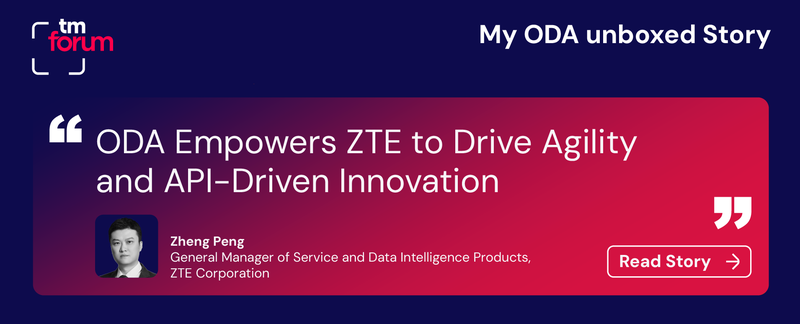ODA
Find out how adopting ODA has enabled ZTE to seamlessly integrate with third-party solutions, delivering faster and more efficient service orchestration.

ODA Unboxed: ODA Empowers ZTE to Drive Agility and API-Driven Innovation
ZTE Corporation is a leading global provider of telecommunications equipment, enterprise solutions, and consumer technology. Headquartered in China, ZTE operates in more than 160 countries and regions, delivering innovative products and services across wireless, wireline, devices, and professional services.
By adopting ODA, ZTE has seamlessly integrated with third-party solutions, enabling faster and more efficient service orchestration.

From ZTE's perspective, the functional scope of our products that have achieved the "Ready for ODA" status encompasses ZTE's OSS domain product Air Net AIMind. This includes Unified Fault Management (UFM), Unified Performance Management (UPM), Unified Event Management (UEM), electronic work order system (eFlow), resource inventory management (IM), and operation and maintenance intelligence toolset. All software products of ZTE adhere to the guidelines of the ZTE Large Communication Model of Nebula architecture, which indirectly meet the requirements of the ODA architecture.
From ZTE's perspective, aligning products with ODA is crucial for two key reasons:
1. Internal Synergy
As a full-value-chain telecom provider, ZTE needed a unified architecture to break down silos and enable cross-product interoperability. ODA provided the standardized framework for component-based design, forming the basis of ZTE's Nebula Architecture. This accelerated product evolution, reduced integration costs, and enhanced cross-functional innovation for OSS domain products like Air Net AIMind.
2. Market Competitiveness
ODA alignment extends interoperability to multi-vendor environments, allowing operators to integrate ZTE components with third-party solutions seamlessly. This preserves existing investments while enabling rapid service orchestration. For example, ODA-compliant Air Net AIMind supports zero-touch automation in heterogeneous networks, reducing operator Opex and positioning ZTE as a leader in multi-vendor collaboration.
For ZTE and its customers, aligning with the Open Digital Architecture (ODA) and advancing an API-centric strategy has yielded tangible benefits across multiple dimensions:
Within ZTE, leveraging the Digital Nebula Architecture, we have established a robust system for cloud-based verification, shelf display, and transaction of internal APIs. This system reduces redundant development through API interoperability, accelerating application building — with particularly notable results in government and enterprise industry applications. It also enhances agility in responding to operators' personalized needs in the Network Operations Centers (NOC) and Service Operations Centers (SOC).
For operators, our ODA-compliant open API practices have fostered a symbiotic ecosystem of equipment and service providers. With the widespread adoption of ODA, cross-vendor API interoperability has been realized, creating a landscape of healthy competition with seamless capability exchange, which significantly lowers operators' operational costs. Our AIMind product, after aligning with ODA, further strengthens operators' competitive edge in open markets.
Moving forward, we will incorporate more products based on the Digital Nebula Architecture into the ODA certification system, further enhancing openness and enabling convenient interoperability with vendors from different sectors, thereby amplifying these benefits.
Adopting ODA presented challenges for ZTE, given our mature product ecosystem: large-scale architectural transformation required significant R&D investment for product restructuring and version switching, with resource reallocation causing short-term disruptions to ongoing businesses.
To tackle this, we first built leadership consensus—senior management recognized the long-term value of cloud nativeization and APIization, solidifying commitment to the transformation. Then, expert groups (tech and standards) guided the process: we primarily referenced TMF ODA while incorporating Gartner’s composable architecture, developing ZTE’s internal Digital Nebula Architecture. Through phased R&D, products were first restructured under this internal architecture, then aligned with ODA domain by domain for TMF certification, balancing transformation with business continuity.
At ZTE, we’ve built a multi-layered approach to help staff gain ODA expertise:
Dedicated standards teams focus on researching TMF’s ODA, SID, and OpenAPI standards, regularly issuing reports and recommendations.
Our Digital Nebula Architecture team includes specialized groups that track the latest ODA updates, developing and disseminating aligned solutions company-wide.
For product teams directly aligning with ODA (e.g., AirNet AIMind), system engineers within R&D lead planning and coordinate cross-domain collaboration.
Additionally, TMF’s certification training courses are widely used to standardize technical language, build foundational knowledge, and foster consensus on leveraging open components and APIs for agile, innovative systems.
Find out more about Ready for ODA here.